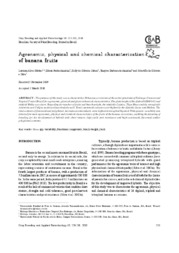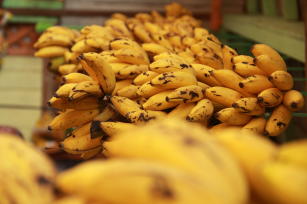Agronomic, physical and chemical characterization of banana fruits.
Agronomic, physical and chemical characterization of banana fruits.
Author(s): MATTOS, L. A.; AMORIM, E. P.; COHEN, K. de O.; AMORIM, T. B. de; SILVA, S. de O. e
Summary: Banana is the second most consumed fruit in Brazil, second only to orange. In relation to its social role, the crop is exploited by rural small-scale enterprises, ensuring the labor retention and recruitment in the country, representing a source of continuos income. Brazil is the fourth largest producer of banana , with a production of 7.0 million tons in 2007, in na area of approximately 500´000 ha. In the same period, India produced 11.7 million tons on 400´000 ha (FAO 2010). The low productivity in Brazil is a result of the lack of commercial varieties that combine short stature, drought and cold tolerance, good post-harvest characteristics and and pest resistance (Silva et al.2002 a). Typically, banana production is based on triploid cultivars, although diploids are important as allele sources for resistance/tolerance to biotic and abiotic factors (Jenny et al. 1999). Banana breeding programs with these genotypes, which are crossed with commercial triploid cultivars, have generated promising tetraploid hybrids with good performance for the agronomic traits of interest and high physical and chemical fruit quality ( Silva et al. 2002a). The information of the agronomic, physical and chemical characterizaton of banana fruit is useful both for the choice of parents for crosses, and in the seletction of diploid elites for the development of improved hybrids. The objective of this study was to characterize the agronomic, physical and chemical characteristics of 26 diploid, triploid, and tetraploid banana accessions.
Publication year: 2010
Types of publication: Journal article
Unit: Embrapa Cerrados
Keywords: Banana, Bunch weight, Componente functional, Cultivar, Functional compounds, Musa spp, Variety, Yield
Related content
Observation
Some of Embrapa's publications are published as ePub files. To read them, use or download one of the following free software options to your computer or mobile device. Android: Google Play Books; IOS: iBooks; Windows and Linux: Calibre.
Access other publications
Access the Agricultural Research Database (BDPA) to consult Embrapa's full library collection and records.
Visit Embrapa Bookstore to purchase books and other publications sold by Embrapa.


